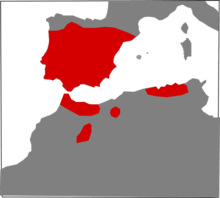Vipera latastei
Vipera latastei is a species of venomous snake in the subfamily Viperinae of the family Viperidae. The species is endemic to extreme southwestern Europe and northwestern Africa.[2] Two subspecies are currently recognized, including the nominate subspecies described here.[5]
| Vipera latastei | |
|---|---|
 | |
| Scientific classification | |
| Kingdom: | Animalia |
| Phylum: | Chordata |
| Class: | Reptilia |
| Order: | Squamata |
| Suborder: | Serpentes |
| Family: | Viperidae |
| Genus: | Vipera |
| Species: | V. latastei |
| Binomial name | |
| Vipera latastei Boscá, 1878 | |
 | |
| Distribution of Vipera latasti. | |
| Synonyms[2] | |
| |
Etymology
The specific name latastei, is in honor of Boscà's French colleague, herpetologist Fernand Lataste,[6] who would a year later return him the honor, by naming after him a discovery of his own, Boscá's newt (Lissotriton boscai ).
Description
V. latastei grows to a maximum total length (including tail) of about 72 cm (28.3 in), but usually less.[3] It is grey in colour, has a triangular head, a "horn" on the tip of its nose, and a zig-zag pattern on its back.[7] The tip of the tail is yellow.
Behaviour
V. latasei can be seen day or night but is usually hidden under rocks. The yellow tip of the tail is possibly used to lure prey.[8]
Geographic range
V. latastei is found in southwestern Europe (Portugal and Spain) and northwestern Africa (the Mediterranean region of Morocco, Algeria and Tunisia).
The type locality given is "Ciudad Real ", emended to "Valencia, Spanien " (Valencia, Spain) by Mertens and L. Müller (1928).[2]
Habitat
V. latastei is found in generally moist, rocky areas, in dry scrubland and woodland, hedgerows, stone walls, and sometimes in coastal dunes.[1]
Reproduction
Females of V. latasei give birth to between two and 13 young. On average, females give birth only once every three years.[1]
Conservation status
The species V. latastei was classified as Near Threatened (NT) according to the IUCN Red List of Threatened Species (v3.1, 2001), and from 2008 is recognised as Vulnerable (VU).[1] It is listed as such because it is probably in significant decline (but likely at a rate of less than 30% over ten years) due to widespread habitat loss and persecution throughout much of its range, thus making the species close to qualifying for Vulnerable. Further population reduction is expected, but is not likely to exceed 30% over the next 10 years, but localized extinctions in parts of its range are possible (e.g., Tunisia). Year assessed: 2005.[9]
It is also listed as a strictly protected species (Appendix II) under the Berne Convention.[10]
Subspecies
| Species[5] | Taxon author[5] | Geographic range |
|---|---|---|
| V. l. gaditana | H. Saint-Girons, 1977 | Southern Spain and Portugal, Morocco, Algeria, Tunisia.[2][3] |
| V. l. latastei | Boscá, 1878 | Most of the Iberian peninsula south of the Pyrenees.[3] |
References
- Miras JAM, Cheylan M, Nouira MS, Joger U, Sá-Sousa P, Pérez-Mellado V, Martínez-Solano I (2009). "Vipera latastei ". The IUCN Red List of Threatened Species™ 2018-1. International Union for Conservation of Nature and Natural Ressources. http://oldredlist.iucnredlist.org/details/61592/0
- McDiarmid RW, Campbell JA, Touré T (1999). Snake Species of the World: A Taxonomic and Geographic Reference, Volume 1. Washington, District of Columbia: Herpetologists' League. 511 pp. ISBN 1-893777-00-6 (series). ISBN 1-893777-01-4 (volume).
- Mallow D, Ludwig D, Nilson G (2003). True Vipers: Natural History and Toxinology of Old World Vipers. Malabar, Florida: Krieger Publishing Company. 359 pp. ISBN 0-89464-877-2.
- United States Navy (1991). Poisonous Snakes of the World. New York: US Government / Dover Publications Inc. 203 pp. ISBN 0-486-26629-X.
- "Vipera latastei ". Integrated Taxonomic Information System. Retrieved 30 April 2008.
- Beolens, Bo; Watkins, Michael; Grayson, Michael (2011). The Eponym Dictionary of Reptiles. Baltimore: Johns Hopkins University Press. xiii + 312 pp. ISBN 978-1-4214-0135-5. ("Vipera latasti [sic]", p. 151).
- "Dangerous Snakes in Spain. Iberia Nature".
- "Lataste's Viper, St. Louis Zoo". Archived from the original on 22 July 2011. Retrieved 1 July 2011.
- 2001 Categories & Criteria (version 3.1) at the IUCN Red List. Accessed 2 September 2007 {{{year}}}.
- Convention on the Conservation of European Wildlife and Natural Habitats, Appendix II at Council of Europe. Accessed 9 October 2006.
Further reading
- Arnold EN, Burton JA (1978). A Field Guide to the Reptiles and Amphibians of Britain and Europe. London: Collins. 272 pp. ISBN 0-00-219318-3. ("Vipera latasti [sic]", pp. 219, 222 + Plate 40 + Map 124).
- Boulenger GA (1896). Catalogue of the Snakes in the British Museum (Natural History). Volume III., Containing the ... Viperidæ. London: Trustees of the British Museum (Natural History). (Taylor and Francis, printers). xiv + 727 pp. + Plates I-XXV. ("Vipera latastii [sic]", pp. 484–485).
- Boscá E (1878). "Note sur une forme nouvelle ou peu connue de vipère ". Bulletin de la Société Zoologique de France 3: 116–121. ("Vipera Latasti [sic]", new species, p. 121). (in French).
- Mertens R, Müller L (1928). "Liste der amphibien und reptilien Europas ". Abh. Senckenb. Naturf. Ges. 45: 1–62. (in German).
External links
| Wikimedia Commons has media related to Vipera latastei. |
- Vipera latastei at the Reptarium.cz Reptile Database. Accessed 2 September 2007 {{{year}}}.
- Vipera latastei at Amphibians and Reptiles of Europe. Accessed 9 October 2006.
